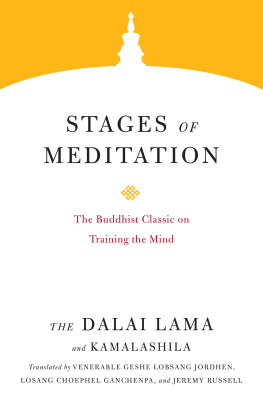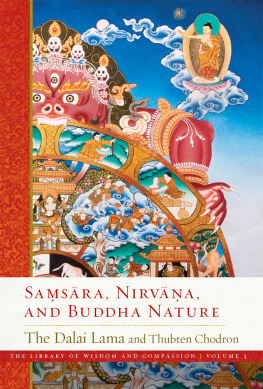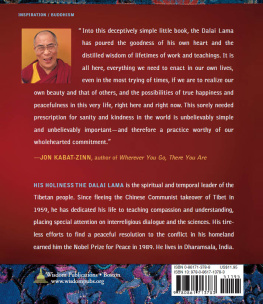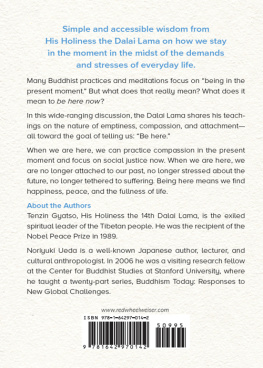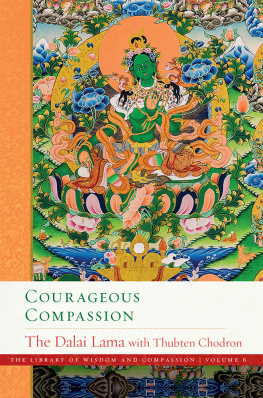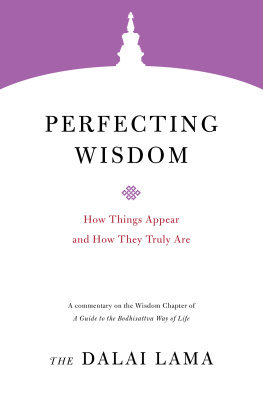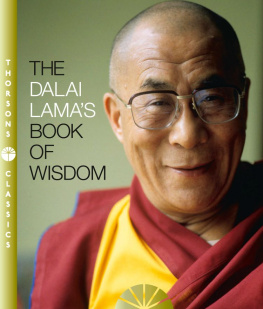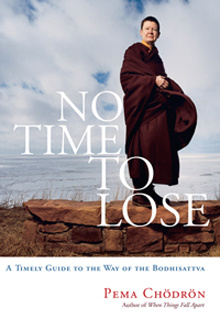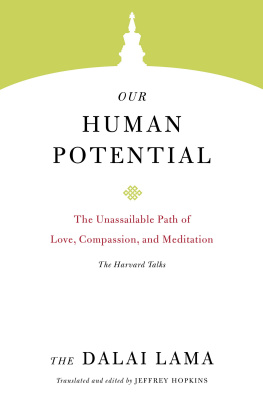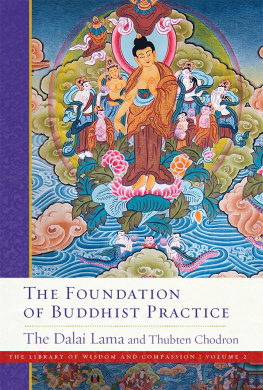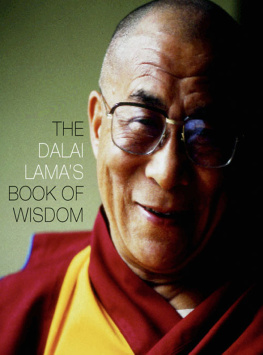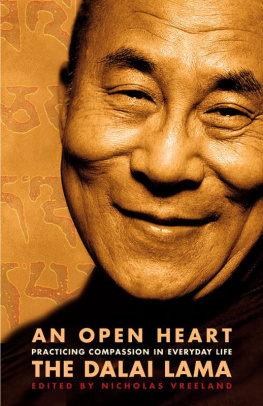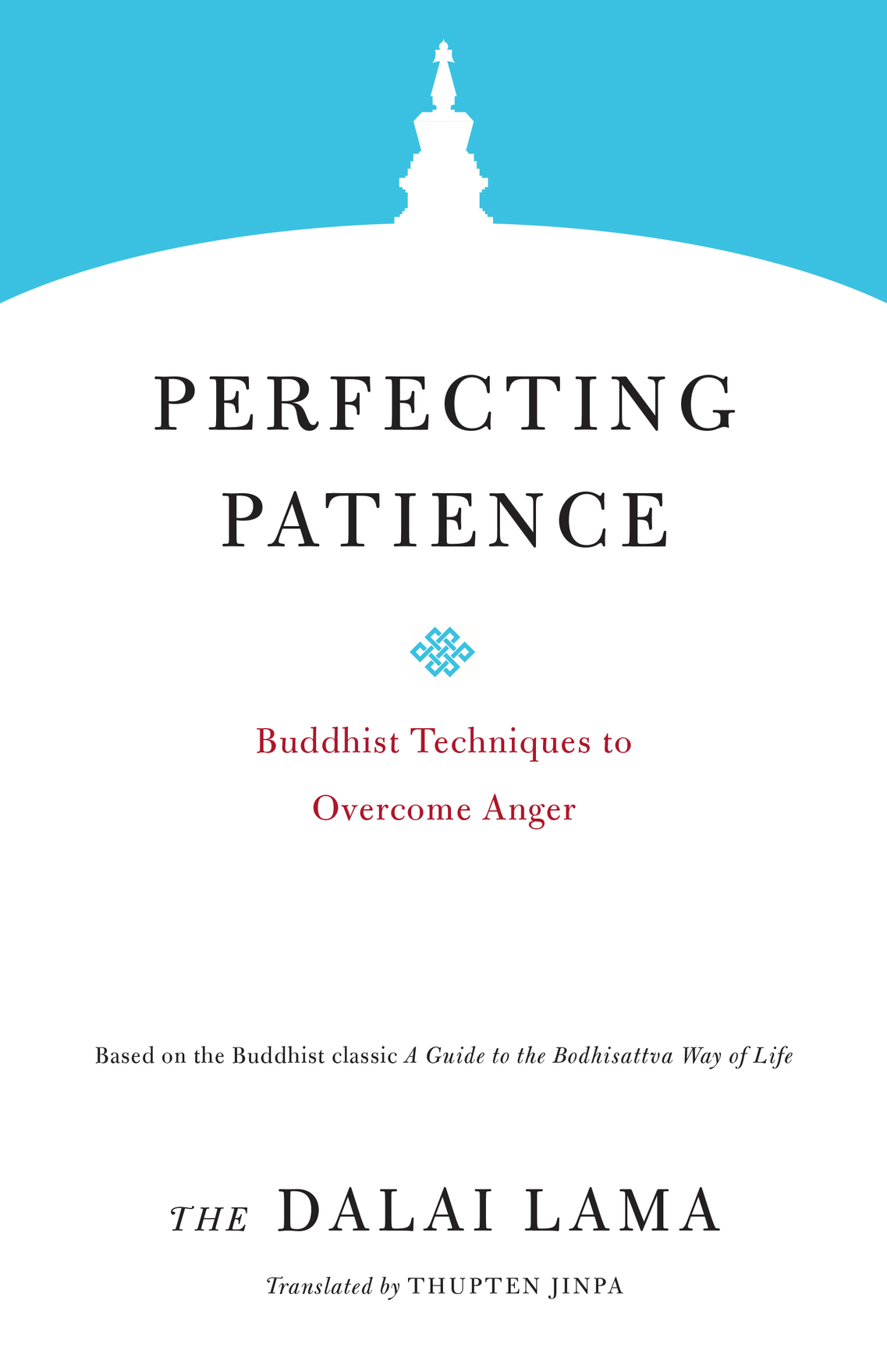Contents
Shambhala Publications, Inc.
4720 Walnut Street
Boulder, Colorado 80301
www.shambhala.com
1999 by His Holiness the Dalai Lama, whose sole agent for these teachings is Arizona Teachings, Inc.
Quotations of Shantidevas Guide to the Bodhisattvas Way of Life are from Stephen Batchelors translation, published by the Library of Tibetan Works and Archives, Dharamsala, India, in 1979.
This book was previously published under the title Healing Anger.
All rights reserved. No part of this book may be reproduced in any form or by any means, electronic or mechanical, including photocopying, recording, or by any information storage and retrieval system, without permission in writing from the publisher.
Cover design by Claudine Mansour
Design 2018 Shambhala Publications, Inc.
Library of Congress Cataloging-in-Publication Data
Names: Bstan-dzin-rgya-mtsho, Dalai Lama xiv, 1935 author. | Thupten Jinpa, translator. | ntideva, active 7th century. Bodhicaryvatra. Title: Perfecting patience: Buddhist techniques to overcome anger/The Dalai Lama; translated by Thupten Jinpa. Other titles: Healing anger | Description: Boulder, Colorado Shambhala, 2018. | Series: Core teachings of the Dalai Lama series | Quotations of Shantidevas Guide to the Bodhisattvas Way of Life are from Stephen Batchelors translation, published by the Library of Tibetan Works and Archives, Dharamsala, India, in 1979. This book was previously published under the title Healing Anger. | Includes bibliographical references and index.
Identifiers: LCCN 2018012744 | ISBN 9781559394796 (paperback)
eISBN 9780834841864
Subjects: LCSH : ntideva, active 7th century. Bodhicaryvatra. | PatienceReligious aspectsBuddhism. | BuddhismDoctrines. | BISAC : RELIGION /Buddhism/Tibetan. | RELIGION / Buddhism / Rituals & Practice. Classification: LCC BQ 3147.B775 2018 | DDC 294.3/5dc23 LC record available at https://lccn.loc.gov/2018012744
v5.3.2
a
F OREWORD
A LL B UDDHIST TEACHINGS begin with a teacher and a student, and the 1993 teachings by His Holiness the Dalai Lama in Phoenix and Tucson, Arizona, were no exception.
As early as 1986, Howard C. Cutler, MD, requested that His Holiness come to Arizona. His invitation was accepted in 1990, and in September of that year he invited Lopn Claude dEstre to join him in requesting specific dates. Finally, in the summer of 1992, word came that His Holiness had agreed to teach in Arizona in the fall of 1993. His Holiness asked what he should teach, and Howard and Claude replied that he should teach whatever he would like to teach. His Holiness then stated that it was the responsibility of the host to determine what would best serve the needs of the students.
It didnt take long for Howard to suggest Shantidevas teaching on patience. Why patience? First, we wanted to request a teaching that would be universal in scope, one that would appeal to Buddhists and non-Buddhists alike. Second, we wanted to request a topic that would be very practical, that one could bring into everyday life. Third, we felt that a lack of understanding of patience, and its reflection in the overwhelming dominance of anger, was endemic to our culture. Anger is one of the roots that cause so much unhappiness, suffering, discord, and violence in our world. It is expressed hundreds of times a day in the mass media, especially television. It is found in how we settle disputes in our highly litigious society; in how our leaders conduct themselves in the halls of Congress; in the increase of domestic violence and child abuse; and in the sense of self-hating and self-loathing that pervades our culture. Politeness, kindness, patience, and compassion often seem a part of our mythical past.
Shantideva states in the very beginning of his chapter on patience that one moment of anger can wipe out a lifetime of merit. At first this seems a harsh statement, but upon reflection it makes a great deal of sense. When we get angry with someone we are often unaware of the effect it has on that person, let alone the ripple effect it causes. Nonetheless, it does indeed have a ripple effect: that person does not hang on to the anger but passes it on, perhaps repeatedly. The antidote to anger is patience, and so the dissemination of Shantidevas wisdom regarding patience becomes a critical need in these times.
In the course of developing this series of teachings, Arizona Teachings, Inc. was formed with Dr. Cutler, Lopn dEstre, and Ken Bacher as founding directors. We decided to take a new approach to the presentation of a teaching by His Holiness. In the past, His Holiness would stay at a nice hotel, a large hall would be rented, and the students would stay at a variety of hotels and motels in the area. Our vision was to have a place where His Holiness could stay that could also accommodate both the teaching hall and the students. In essence we wanted to create a campus for five days where everyone who attended the teachings could relax and enjoy each others company. It was important that the setting be beautiful and peaceful, a place where His Holiness and his entourage, lay students, and their families would feel enriched by the natural setting. We chose the Sheraton EI Conquistador Resort, surrounded by the Sonora Desert with a backdrop of the Catalina Mountains in Oro Valley just north of Tucson.
The morning of His Holiness arrival in Tucson was marked by deep blue desert skies and a double rainbow as we approached Oro Valley. On seeing the natural beauty of the setting for the teachings, His Holiness exclaimed that it reminded him very much of Lhasa.
And so, with these good omens, on September 11, 1993, in the Year of the Water Bird, at Pusch Ridge in the state of Arizona, numberless gods and demigods, 1,600 humans and bodhisattvas, asuras, and gandharvas assembled to hear His Holiness Tenzin Gyatso, the Fourteenth Dalai Lama of Tibet and the living incarnation of Bodhisattva Avalokiteshvara, present and comment on Acharya Shantidevas teaching on patience and the bodhisattvas way of life. We pray that these teachings are of benefit to all sentient beings.
A CKNOWLEDGMENTS
Funding and support of Arizona Friends of Tibet, and particularly its president, Peggy Hitchcock, made it possible for our fledgling organization to announce the teachings and begin the myriad arrangements required for the visit. Most of the details of the visit were handled by nearly three dozen volunteers, coordinated by Bonnie Cheney. Computer record-keeping systems were created by Dan Crowell, G. Greg Bender, and Richard Laue.
Volunteers transcribed the teachings presented in this book from the sixteen hours of oral teachings delivered by His Holiness: thanks go particularly to Julie Jones, Karen Garland, Amy Zehra Conner, and Julie Montgomery. The transcript was then edited by Ken Bacher and put into final form by Kate Bloodgood and Susan Kyser of Snow Lion Publications, with crucial assistance from Geshe Thupten Jinpa. Some small liberties have been taken with the arrangement of the transcribed material to more effectively present it in book form; the editors, however, have striven to preserve the voice of the Dalai Lama as much as possible.


